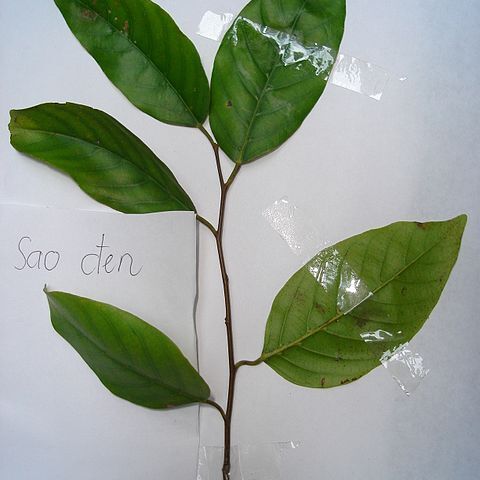Small or medium-sized, occasionally large, trees; bole usually tapering, frequently branching low; buttresses usually thin, sometimes thick; stilt roots and flying buttresses sometimes present; crown, in small species, persistently lanceolate, monopodial, the branches ± horizontal and pendent; becoming densely evenly hemispherical in large trees, with many small straight branches radiating from the bole apex. Bark surface at first smooth, chocolate and grey mottled, hoop-marked; remaining so or becoming cracked and flaked, or fissured. Parts with or without indumentum of broad or narrow lobed hairs. Twigs slender, usually branching horizontally; stipule scars small, inconspicuous. Stipules linear, fugaceous (subpersistent in saplings). Leaves small or medium-sized, or narrowly oblong, large; nerves (see Fig. 64a) either scalariform, with scalariform tertiaries, or 'dryobalanoid' with ± indistinct nerves, and with many equally prominent, but more or less shorter, secondaries, and indistinct reticulate tertiaries, superficially resembling those of Dryobalanops; or intermediate between these two types: 'subdryobalanoid', with more prominent reticulate or partially scalariform tertiaries, more prominent nerves, and fewer, shorter, intermediates. Petiole never geniculate. Inflorescence paniculate, slender, terminal or axillary. Flower buds small, ovoid or rarely globose. Sepals imbricate; 2 outer ovate, ± obtuse, thickened; 3 inner suborbicular, frequently mucronate, thin at the margins. Petals oblong, connate at base and falling in a rosette. Stamens 10, 15 or up to 38 (H. plagata), in 1-3 verticils or irregular, falling with the petals; filaments broad and compressed at base, tapering medially and filiform below the anthers, anthers subglobose, tapering apically, latrorse; with 4 pollen sacs, the outer pair somewhat the larger; appendage to connective usually at least twice as long as anther, slender, glabrous or minutely glandular tuberculate. Ovary glabrous or tomentose, ovoid and with indistinct stylopodium marked by a ring of hairs at the apex of the ovary, or with a distinct stylopodium and hence pyriform, hour-glass-shaped, or cylindrical; style long or short, glabrous; stigma minute (except H. ferrea). Fruit relatively small: 2 outer fruit calyx lobes prolonged, spatulate; 3 inner lobes short, or 5 short, subequal; lobes thickened and saccate at base. Nut ovoid, usually glabrous, with a distinct apical stylopodium if present in the flower. Pericarp splitting at germination into 3 valves (H. pachycarpa) or irregularly; cotyledons photosynthetic, subequal; first pair of leaves opposite, followed by spiral leaves or an initial whorl of 3; branching of sapling mainly at initiation of each period of growth by leader, hence appearing pagoda-like.
More
Trees evergreen, of main canopy or understory, white resinous. Stipules caducous, small; leaf blade thinly leathery; lateral veins pinnate; tertiary veins scalariform (in Chinese species) [or subreticulate], margin entire. Flowers sessile or shortly pedicellate, in lax panicles of unilateral racemes; bracts early caducuous, linear. Calyx segments imbricate. Exposed parts of petals usually pubescent in bud. Stamens (10-)15, slightly connate and adnate to petals; anthers ovoid, small, subequal; connectival appendages aristate or filiform. Ovary ovoid, with prominent filiform style, or hourglass-shaped, with short tapering style. Fruit ovoid or globose; pericarp usually thin, waxy; 1-seeded, closely surrounded by thickened base of calyx segments; 2 fruit sepals winglike, linear, or all orbicular or ovate, subequal.
Main canopy or understorey, rarely emergent, trees of lowland evergreen forests; and also semi-evergreen forests where there are more species, many of them local endemics, than any other dipterocarp genus. Several are semi-gregarious, several riparian.

